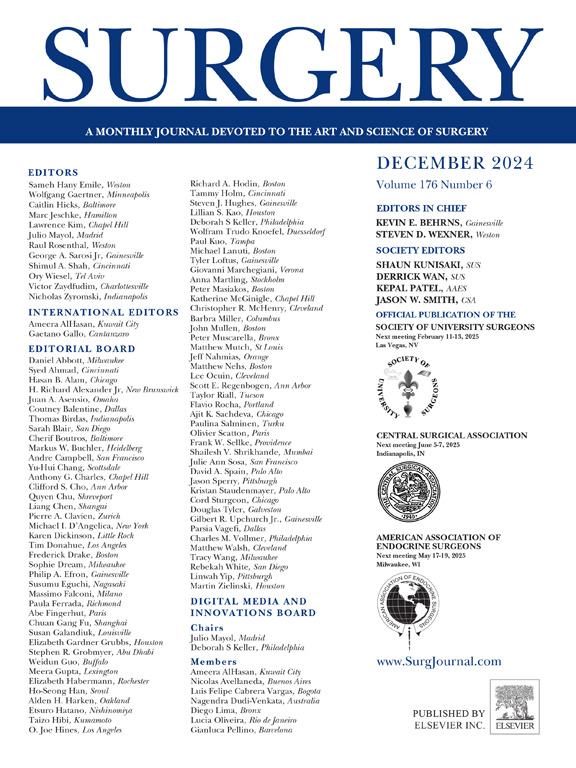Predictors of return to work after traumatic injury: Associations of employment with long-term patient-reported outcomes
IF 2.7
2区 医学
Q1 SURGERY
引用次数: 0
Abstract
Background
After traumatic injury, patients face significant physical, psychosocial, and economic barriers to recovery. In this study, we evaluate return to work as an indicator of holistic recovery and hypothesized that patients with stronger baseline social support would be more likely to be employed at follow-up.
Methods
From October 2019 - July 2024, we prospectively collected data on employment, social support and Patient-Reported Outcomes Measurement Information System-29 domains (depression, anxiety, physical function, sleep disturbance, fatigue, ability to participate in social roles, pain intensity, and pain interference in daily activity) for adult trauma patients admitted to an urban, academic, level-1 trauma center. Participants were screened at the time of injury and had at least 1 follow-up at 6 or 12 months. Injury characteristics were collected from the institutional trauma registry. Using multivariate logistic regression analysis, we assessed relationships between follow-up employment status, baseline social support, and follow-up Patient-Reported Outcomes Measurement Information System-29 domains.
Results
Complete data were available for 310 patients, with 175 patients employed at baseline. In total, 54.2% of these patients reported return to work at 6- or 12-month follow-up. No significant differences were identified between employment and social support at baseline, 6- or 12-month follow-up. In multivariable analysis, employment was associated with better pain intensity scores (odds ratio, 0.77 [0.65–0.92], P = .003) and physical function (odds ratio, 0.30 [0.12–0.75], P = .01)
Conclusion
Post-injury return to employment was not associated with social support. However better patient-reported outcomes were associated with return to employment. Employment may be an important marker of recovery after injury and a pathway to economic stability and social recovery.

创伤后重返工作的预测因素:就业与长期患者报告的结果的关系
创伤性损伤后,患者在康复过程中面临着显著的生理、心理和经济障碍。在本研究中,我们评估重返工作作为整体康复的一个指标,并假设基线社会支持较强的患者更有可能在随访中被雇用。方法:从2019年10月至2024年7月,我们前瞻性地收集了一个城市学术一级创伤中心收治的成人创伤患者的就业、社会支持和患者报告的结果测量信息系统29个领域(抑郁、焦虑、身体功能、睡眠障碍、疲劳、参与社会角色的能力、疼痛强度和日常活动中的疼痛干扰)的数据。参与者在受伤时进行筛查,并在6或12个月时至少进行一次随访。从机构创伤登记处收集损伤特征。使用多变量逻辑回归分析,我们评估了随访就业状况、基线社会支持和随访患者报告结果测量信息系统-29域之间的关系。结果310例患者获得完整数据,175例患者在基线时接受治疗。总共有54.2%的患者在6个月或12个月的随访中返回工作岗位。在基线、6个月或12个月的随访中,没有发现就业和社会支持之间的显著差异。在多变量分析中,就业与较好的疼痛强度评分(优势比0.77 [0.65 ~ 0.92],P = 0.003)和身体功能(优势比0.30 [0.12 ~ 0.75],P = 0.01)相关。结论伤后重返就业与社会支持无关。然而,更好的患者报告结果与重返工作岗位有关。就业可能是受伤后恢复的重要标志,也是经济稳定和社会恢复的途径。
本文章由计算机程序翻译,如有差异,请以英文原文为准。
求助全文
约1分钟内获得全文
求助全文
来源期刊

Surgery
医学-外科
CiteScore
5.40
自引率
5.30%
发文量
687
审稿时长
64 days
期刊介绍:
For 66 years, Surgery has published practical, authoritative information about procedures, clinical advances, and major trends shaping general surgery. Each issue features original scientific contributions and clinical reports. Peer-reviewed articles cover topics in oncology, trauma, gastrointestinal, vascular, and transplantation surgery. The journal also publishes papers from the meetings of its sponsoring societies, the Society of University Surgeons, the Central Surgical Association, and the American Association of Endocrine Surgeons.
 求助内容:
求助内容: 应助结果提醒方式:
应助结果提醒方式:


